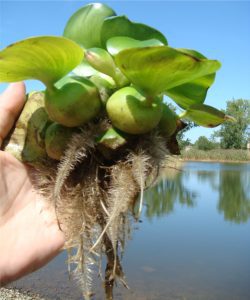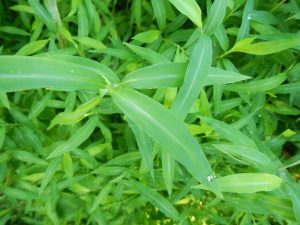Early detection is the process of observing and documenting an invasive species before it has established widespread populations. While even the best prevention efforts cannot stop all invasive species, early detection is a critical second defense. It increases the likelihood that localized populations will be found, contained, and eradicated before they become widely established. Early detection can also slow range expansion and avoid the need for costly, long-term control efforts. Read on to learn about how you can get involved and help improve WNY PRISM’s early detection efforts.
Despite the best efforts of our staff, partners, volunteers and community members, new species can still sneak in unnoticed. Once introduction occurs it is important to focus on the early detection of these species. An invasive species is generally considered “early detection” when it occurs in only a few areas, or in very low numbers, within a selected region. Special importance is placed on species that pose the greatest threat to WNY as determined by its potential negative impacts and ability to spread.
Finding early detection priority species before they become established gives managers the greatest chance of success in eradicating an infestation, as demonstrated by The Invasion Curve. Not only do managers have more options, addressing an infestation in its early stages is also the most cost-effective time for management. We are currently featuring three of our early detection species; water lettuce (Pistia stratiotes), water hyacinth (Eichhornia crassipes) and Japanese stiltgrass (Microstegium vimineum).
Water Lettuce (Pistia stratiotes) and Water Hyacinth (Eichhornia crassipes)

A water lettuce (Pistia stratiotes) population floating in a water garden.
Water lettuce is an often free-floating, freshwater aquatic plant that resembles an open head of lettuce. It can grow in ponds, lakes and calmer areas of rivers and streams. It forms thick mats that block sunlight, hinder native plant growth and fish communities and impact recreation activities like swimming and boating. Water lettuce was introduced to North America as an aquarium and water garden plant. It often spreads by the release of aquarium plants and is still sold in some WNY nurseries. Currently, water lettuce has only been confirmed in a few areas of WNY, including a stretch of Ellicott Creek in Amherst, an area of Erie Canal near Wendelville, and Hyde Park Lake in Niagara.

A water hyacinth (Eichhornia crassipes) plant and its roots.
Water hyacinth is another freshwater, free-floating aquatic plant. It is a perennial, but will grow as an annual in areas where it is unable to survive the winter. Water hyacinth can reproduce rapidly, doubling its population in a week. It forms dense mats which have similar impacts as water lettuce. In addition, the reduction of open water threatens waterfowl.
Like water lettuce, water hyacinth was introduced as an ornamental water garden plant. It is mostly spread through aquarium and water garden release. Unlike water lettuce, however, water hyacinth has been reported at more than a few areas in WNY. These locations include Unity Island, along Ellicott and Ransom Creeks, Erie Canal, Oppenheim Park and Woods Creek in Buckhorn Island State Park.
So far this summer, PRISM staff have monitored two sites for water lettuce and water hyacinth; Ellicott Creek and Erie Canal. Neither species was found, but it’s still early in the season and we’ll be out again a little later. WNY PRISM plans to survey three additional sites in the coming months for water hyacinth as well; Unity Island, Hyde Park and Oppenheim Park. If water hyacinth is not detected on Unity Island this year, it will be the fifth in a row that it has been absent, which will allow us to presume it has been eradicated from the location. If we hit this milestone, it will join the Ransom Creek site, which was presumed eliminated after last year.
Japanese Stiltgrass (Microstegium vimineum)

Japanese Stiltgrass (Microstegium vimineum), leaf blades showing silver, off-center, mid-rib.
Japanese stiltgrass grows in a wide range of habitats including yards, woodlands, streambanks and riparian areas. It spreads quickly to form dense patches, displaces native plants and interrupts soil nutrient cycling. Japanese stiltgrass is easily identifiable by an off-center, silver stripe running the length of its long, thin leaves.
The plant was discovered in the Village of East Aurora in Erie County in 2017. Since then, the plant has been confirmed in Allegany, Cattaraugus, Chautauqua, Niagara and Wyoming counties. In recent years, PRISM staff have observed populations along sections of Cazenovia Creek in West Seneca, Ebenezer, East Seneca, and Knox Farm State Park. To combat the spread of Japanese stiltgrass, WNY PRISM staff is continually surveying for the plant across the region. WNY PRISM also continues to host volunteer workdays to remove Japanese stiltgrass from locations along Cazenovia Creek. Keep reading to see how you can join the effort!
How You Can Help!

Volunteers at a 2021 Japanese stiltgrass removal workday.
WNY PRISM staff can’t monitor the entire region alone, which is where Community Scientists like you come in! While you are out this summer, we ask that you keep an eye out for our early detection priority species.
If you would like to help WNY PRISM with our management efforts this summer, sign up for one or more of our volunteer workdays! We will work to remove Japanese stiltgrass from areas along Cazenovia Creek and answer any questions you may have about invasive species while helping to protect our natural resources. All you need is long pants, closed-toe shoes and a water bottle. Gloves and snacks will be provided. Registration is required. Click here to register.
If you believe you have found any of these species, you can upload the information into iMapInvasives, a database that catalogs invasive species throughout New York State. WNY PRISM can provide you with an iMapInvasives tutorial to get you started. More information on how to collect and report data can be found on our Early Detection page. Finding and reporting these species only takes a moment, but has lasting impacts on the environment. The more information invasive species managers have, the more effective management efforts will be!


